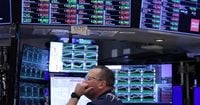On October 8, 2025, Wall Street delivered a performance that left investors both exhilarated and cautious, as major U.S. stock indexes notched fresh records despite the ongoing government shutdown and swirling economic uncertainty. The S&P 500 and the Nasdaq Composite reached new heights, buoyed by a resurgent appetite for technology stocks and an unrelenting wave of enthusiasm for artificial intelligence, even as the Dow Jones Industrial Average lagged behind, closing flat for the day.
The S&P 500 closed up 0.6%, marking its 33rd record close of the year, while the Nasdaq Composite jumped 1.1%, notching its 32nd closing high, according to The Wall Street Journal. Meanwhile, the Dow barely budged, finishing the session at 46,601.78, a mere 1.20 points higher—a statistical rounding error in the grand scheme of things. The contrasting fortunes among the major indexes were a direct reflection of the day’s sectoral winners and losers, as investors rotated money into high-growth, high-risk corners of the market.
Tech stocks, in particular, were the day’s undisputed champions. The tech-heavy Nasdaq led the charge, propelled by megacap companies at the forefront of the artificial intelligence revolution. As Bill Merz, head of Capital Market Research at U.S. Bank Wealth Management, told Reuters, "The theme continues to be aggressive growth, with a constant supply of deal announcements, one after the other that are related to the AI space. Anything attached to AI is garnering a significant amount of attention." The Invesco S&P 500 High Beta ETF, a proxy for the market’s riskiest stocks, outperformed the broader market. Funds focused on growth, momentum, and small-caps also surged, while more defensive plays—dividend, value, and low-volatility stocks—were left in the dust.
Among the standout performers, AMD stole the spotlight, soaring 11.4% and extending its weekly gain to more than 43%, as reported by Reuters. The chipmaker’s rally was fueled by excitement over its recent deal with OpenAI, which investors see as a major coup in the heated race for AI dominance. Oracle shares also gained 1.5% after a tough previous session, as investor sentiment rebounded despite lingering questions about the profitability of its AI cloud business.
It wasn’t just tech that had a good day. Dell jumped 9.1% after multiple brokerages raised their price targets, and Freeport-McMoRan advanced 5.3% following a Citigroup upgrade. On the flip side, Intercontinental Exchange dropped 2.2% after Barclays cut its price target, and Joby Aviation tumbled 8.1% after pricing a hefty share sale at a steep discount.
But what’s driving all this risk-taking in the face of so much uncertainty? Part of the answer lies in the ongoing U.S. government shutdown, which entered its eighth day on Wednesday. With official economic data releases on hold, investors have been left to read the tea leaves elsewhere—mainly in corporate earnings and the minutes from the Federal Reserve’s September policy meeting. As Zachary Hill, head of portfolio management at Horizon Investments, observed, "The topical discussion is about the extent of Fed cuts and how restrictive or not policy is. More broadly, the Fed is definitely not in a great position without public sector economic data as (the shutdown) continues to drag on, which really just makes policymakers' already challenging job even tougher."
Indeed, the minutes showed a divided committee: policymakers expressed concern over rising labor market risks but remained wary of persistent inflation. Most agreed that "it likely would be appropriate to ease policy further over the remainder of this year," according to the minutes, but the timing and pace of those moves remain up in the air. Market participants are betting on action sooner rather than later. Interest-rate futures now price in a 95% chance of another cut at the Fed’s October 29 meeting, with a 92.5% likelihood of a 25 basis point reduction, according to Reuters and The Wall Street Journal. The CME FedWatch Tool shows a 77.6% chance of a half-point cut by year-end, with only a tiny sliver of traders expecting no change.
Meanwhile, the government shutdown has had some unexpected side effects. With no new economic data to pour over, Wall Street’s bullish narrative—built on hopes for lower interest rates and a resilient economy—has gone largely unchallenged. The lack of official information has, as Kit Juckes, chief FX Strategist at Société Générale, put it, "likely to persist as long as its main drivers remain in place: lack of information about the US economy due to the Federal shutdown; concerns about the attraction of the euro because of its trade-weighted appreciation, worries about French politics and recent mixed economic data; and last but by no means least, fears of yen-unfriendly policies in Japan."
The dollar, meanwhile, continued its climb, particularly against the yen, as investors weighed the implications of the shutdown and global geopolitical jitters. Treasury yields reflected the market’s uncertainty: the 2-year note rose to 3.58% and the 10-year yield held steady at 4.13%, while longer-dated yields barely budged after the first government auction of 10-year notes since the shutdown began.
In this climate of uncertainty, gold and other alternative assets have become the safe havens of choice. Gold futures surged more than 1% to a new high above $4,000 per ounce, extending a record-setting run, according to The Wall Street Journal. Silver prices also climbed, nearing a record set back in 1980. This so-called "debasement trade"—where investors flock to hard assets amid worries about the dollar and other major currencies—has also helped bitcoin and other cryptocurrencies find new fans. Shares in gold miners Newmont and Gold Fields rose 1.7% and 3.7% respectively, as reported by Reuters.
Trading activity was brisk, with volume on U.S. exchanges reaching 20.70 billion shares, comfortably above the 20-day average. Advancing issues outnumbered decliners by a healthy margin: on the NYSE, the ratio was 1.74-to-1, and on the Nasdaq, it was 1.81-to-1. New highs outpaced new lows across the board, a clear sign of bullish sentiment. The S&P 500 posted 35 new 52-week highs and just 6 new lows, while the Nasdaq recorded 129 new highs and 62 new lows.
Looking ahead, investors are bracing for the start of third-quarter earnings season next week, with hopes that corporate results will provide some much-needed clarity in the absence of government data. The focus is squarely on technology and AI, with every earnings report and deal announcement scrutinized for signs of who’s leading—and who’s falling behind—in the race for future growth.
As the government shutdown drags on and the Fed weighs its next move, Wall Street finds itself in a peculiar limbo—caught between exuberance over technological innovation and the nagging sense that the next big shock could be just around the corner. For now, though, the bulls are running, and the records keep falling.





